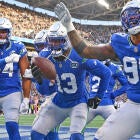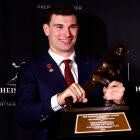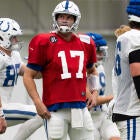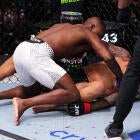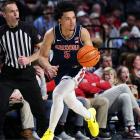
Familiar Longhorns open spring practice at a very different speed
'We changed so much personnel over the last couple of years that we felt like it gave defenses a chance to match with us in packages.'
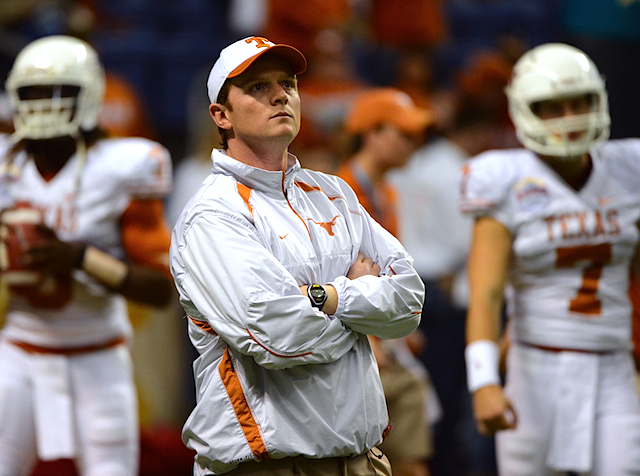
Major Applewhite is entering his sixth year on Texas' staff but his first as the primary play-caller. (USATSI)
Ignore the calendar: In Texas, the seasons are governed by the gridiron, and spring is initiated not by the movements of the heavens but by the start of spring practice for the Longhorns, which kicks off Thursday with nearly a month to spare before the equinox. Texas is the first major outfit in the nation to reconvene in 2013 form. With virtually the entire depth chart returning intact, it's also the one that has undergone the least change on paper from 2012.
Once they hit the field, though, there will be at least two significant changes, both stemming from the departure of offensive coordinator Bryan Harsin for the head coaching job at Arkansas State. His successor is ex-Texas quarterback Major Applewhite, who has carried the title of "co-offensive coordinator" for the last two years but will be assuming play-calling duties for the first time.
And, according to his boss, Applewhite will be calling them much more quickly: In search of a spark, head coach Mack Brown has promised to emphasize a hurry-up, no-huddle style that he hopes will take shape over the next few weeks then take off when it's unveiled in the Orange-White scrimmage on March 30.
The goal, as Brown explained it earlier this month, is not to revamp the playbook -- "we're not going to be the option-type team like Oregon" -- but to accelerate the pace to an Oregonesque blur. That also means significantly fewer substitutions than demanded by Harsin, whose philosophy included an array of personnel packages designed to maximize the Longhorns' various strengths and mentally overload the defense.
It also required using most of the 25-second play clock between plays to get all the moving parts in place, an interval that Brown hopes to cut in half.
"We changed so much personnel over the last couple of years that we felt like it gave defenses a chance to match with us in packages," Brown said on Feb 6. -- National Signing Day. "So we're trying to get a group on the field and keep them on the field and run a lot of different plays and formations from the same personnel so the defense cannot rest."
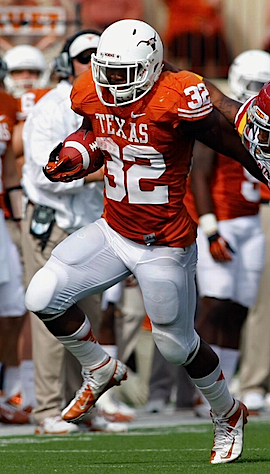 Johnathan Gray led Texas in rushing as a true freshman. (USATSI) |
If the tempo is novel, the need for a new edge feels like old hat.
Under Brown, philosophy has always deferred to personnel: Since his arrival in 1998, the offense has mutated several times, from an emphasis on downhill, between-the-tackles running to suit the talents of workhorses Ricky Williams and Cedric Benson, to a shotgun/zone-read scheme to accommodate nimble quarterback Vince Young, to a spread passing attack that hinged on the uncanny accuracy of Colt McCoy -- all of the above executed under the same coordinator, Greg Davis, who followed Brown to Austin from North Carolina. Williams won the Heisman Trophy, Young and McCoy both finished as runners-up and Texas won more games in Brown's first 12 seasons than any other team in the nation.
At their best, his teams have succeeded not by innovation but by identifying great players and adjusting accordingly to get the ball in their hands as often as possible.
The flip side of that trend is the malaise of the last three years, consecutive disappointments that have failed to produce anyone approaching the reliable star power of the previous decade. (In fact, since the mass exodus from the McCoy-led team that won the Big 12 title and played for the BCS crown in 2009, exactly one Longhorn player has earned All-Big 12 status on offense: Guard Trey Hopkins, who earned a second-team nod last year.)
For most of 2012, it was uncertain where the production was going to come from on any given weekend. Starting quarterback David Ash was occasionally brilliant and occasionally found himself benched for ineffectiveness. Three guys had their turn as the featured tailback, delivered a big game or two and spent the rest of the season struggling for carries.
Against competent defenses -- Oklahoma, TCU, Kansas State, Oregon State -- the entire offense seemed to grind to a halt for long stretches and was suddenly gripped by turnovers. Despite his ostensible promotion, after two years, nine losses and countless quarterback changes, the offense that Harsin bequeaths to Applewhite is as far from a coherent identity as it has ever been.
There is still some hope for Ash, only a sophomore, to make the leap from maddening underclassman to veteran assassin that McCoy made at the same point in his career. And picking up the pace is an obvious place to start in search of a spark: In the relentlessly up-tempo Big 12, only the plodders at Kansas State got off fewer snaps per game last year; in 2011, the Longhorns only managed to outpace K-State and Kansas. The high-octane, no-huddle attacks at Baylor, Oklahoma, Oklahoma State and West Virginia (and before West Virginia, at Texas A&M) have been more aggressive, and far more productive.
But the league is ripe for the taking, having crowned four schools as conference champions over the last four years. Both of the 2012 co-champs, Kansas State and Oklahoma, are facing significant attrition, led by their celebrated senior quarterbacks. For Texas, the learning curve should not be very steep for a lineup that returns both quarterbacks, the top four running backs, four of the top five receivers and all five regular starters on the offensive line (though Hopkins will miss the spring due to a leg injury).
The offense returns 11 regular starters who have combined for more than 200 career starts. Most of them will be lining up alongside the same faces for the third or fourth year in a row.
If there's a time to hit the gas pedal, 2013 is it.








